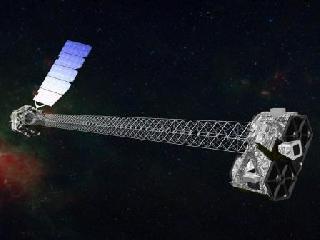
Artist's concept of NuSTAR on orbit. Photo: NASA/JPL-Caltech.
PASADENA, CALIFORNIA (BNS): NASA's Nuclear Spectroscopic Telescope Array (NuSTAR) has begun its mission to unveil secrets of buried black holes.
The observatory began its journey on Wednesday perched atop Orbital's Pegasus XL rocket. At 9:00:35 a.m. PDT (12:00:35 p.m. EDT), the rocket dropped, free-falling for five seconds before firing its first-stage motor, NASA said.
About 13 minutes after the rocket dropped, NuSTAR separated from the rocket, reaching its final low Earth orbit. The first signal from the spacecraft was received at 9:14 a.m. PDT (12:14 p.m. EDT) via NASA's Tracking and Data Relay Satellite System.
NuSTAR will use a unique set of eyes to see the highest energy X-ray light from the cosmos. The observatory can see through gas and dust to reveal black holes lurking in our Milky Way galaxy, as well as those hidden in the hearts of faraway galaxies.
The mission's unique telescope design includes a 33-foot (10-meter) mast, which was folded up in a small canister during launch.
In about seven days, engineers will command the mast to extend, enabling the telescope to focus properly. About 23 days later, science operations are scheduled to begin.
In addition to black holes and their powerful jets, NuSTAR will study a host of high-energy objects in our universe, including the remains of exploded stars; compact, dead stars; and clusters of galaxies.
The mission's observations, in coordination with other telescopes such as NASA's Chandra X-ray Observatory, which detects lower-energy X-rays, will help solve fundamental cosmic mysteries.
NuSTAR also will study our sun's fiery atmosphere, looking for clues as to how it is heated.
 Previous Article
Previous Article Next Article
Next Article













The Indian Air Force, in its flight trials evaluation report submitted before the Defence Ministry l..
view articleAn insight into the Medium Multi-Role Combat Aircraft competition...
view articleSky enthusiasts can now spot the International Space Station (ISS) commanded by Indian-American astr..
view article